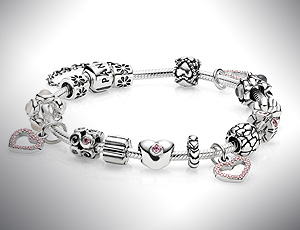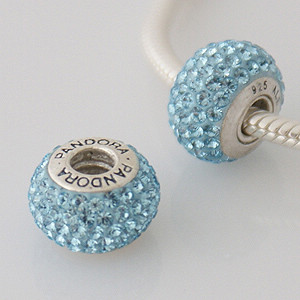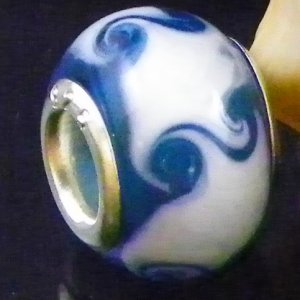
With the growing popularity of Pandora in recent years, there has also been been a steady rise in the number of counterfeit and imitation pieces that try to copy their distinct and beautiful style. It’s especially difficult given that for a lot of us collectors, buying online is the only way to get our hands on some of the rarer pieces that were either retired before we got into Pandora or were not available in your country. In this post I’ll write about some tips and basic information on how to spot a fake Pandora charm.
-
Does it have the right Pandora markings? All Pandora products are engraved with several distinct markings that can be used to distinguish them from imitators or other brands.
-
The ALE marking. The first and most notable marking is the three letter marking “ALE”. This marking comes from Per Enevoldsen, the original founder of the Pandora jewelry company, and are the initials of his father Algot Enevoldsen. All Pandora charms and and accessories will have this ALE hallmark engraved on the piece, usually close to where the sterling silver or gold mark is. If the piece does not have this mark, then for sure it is not a genuine Pandora piece.
This used to be an easy identifier of a counterfeit, but the imitators out there are getting better at copying the Pandora pieces and will often include the ALE mark now so it’s not a guaranteed indicator. -
Crown over the O. This marking is only on the barrel clasps – another good indication that the bracelet is authentic. However, older Pandora bracelets/necklaces do not have the crown over the O (my two-tone necklace does not have the crown) because they did not come with the crown before 2008. This is usually because the store had older inventory, so no need to worry if that’s the only oddity.
-
The Sterling 925 and Gold 585 markings. These two numbers, the 925 for sterling silver and 585 of 14k gold, is an international standard and required markings for jewelry pieces made from these two materials. While it sounds nice to have something made from pure silver or gold, these precious metals are actually very soft and benefit greatly from having other metals mixed in with them to form an alloy. Sterling silver must contain at least 92.5% silver, so hence the 925 marking that’s seen on all Pandora sterling silver pieces. The same goes for 14 karat gold, which must contain at least 58.5% gold. Pandora gold pieces are engraved with the number 585, again usually near where the ALE marking is placed.
In addition to the 925 mark on Pandora silver jewelry, beginning in June 2011 Pandora has added an “S” in addition to 925, a change in the international standard to identify silver jewelry. So don’t worry if some of the older charms have no “S” and only the traditional 925.
As for two-tone (duotone) charms and jewelry, Pandora will only stamp it with the S 925 or 925 mark since all the two-tone charms are still mainly silver with gold accents.
Like the ALE trademark of the Pandora line, the lack of a 925 or 585 numerical marking on a piece is a surefire sign that it’s a fake piece. Counterfeiters are getting wiser, however, and will often include these marks on the higher end imitation pieces even if the charm or jewelry piece is not actually made from that material. -
Is the piece in the Pandora official catalog, or if it’s been retired, was it ever in the catalog?
Beyond the markings, the next step you can do when trying to verify if a Pandora piece is authentic or not is to consult the Pandora catalog. Pandora’s website is a good first stop when trying to lookup a charm or accessory; all of Pandora’s current collections are laid out in relatively easy to browse sections with high resolution pictures that you can look at. If the charm you’re examining is not on the website, or if it is but it looks “off” in some way, like with significant color variations or sculpting differences, then you may have a counterfeit charm.
The complication though is that Pandora is pretty aggressive about retiring portions of their collections on a regular basis. When they retire a piece they also remove it from their website, making it a bit more difficult to verify older charms that are no longer carried in retail stores. These pieces will usually have some kind of web presence, however, either from other jewelry websites and blogs (like Charms Addict! :)) that will talk about them or have listings for these retired pieces so some Google searching will help you here. -
How is the actual quality of the piece? The craftsmanship and quality of a charm or jewelry piece is often difficult to determine unless you are handling it in person. If you’re buying online, you’ll probably only have access to photos (hopefully high resolution photos) of the piece that you are looking to buy. If the photos are good, you may have enough information to make a determination. My advice is never to buy a charm off eBay with only a stock photo provided – ask the seller for an actual picture of charm, and if they refuse then it may be an indication that they’re trying to pull a fast one.
-
How is the craftsmanship and detailing? Pandora charms are all beautifully handmade by artisans that work directly with the precious metals, stones, and colored Murano glass. Authentic Pandora pieces will have a high level of sculpting and detail in their silver and gold pieces — lines will be crisp, and the sculpts will be polished and well shaped. If the detailing on the piece you’re looking at feels flat or a bit “soft”, then it’s possible that the piece is an imitation. Counterfeit pieces are often manufactured from molds that are taken of an original piece — these molds already lose some fidelity as a result of being a copy, and then they degrade quickly as more and more pieces are made from them.
If you’re buying a Murano glass bead, how does the glass look? Is the glass even and polished smooth, and are the details on it high quality and uniform? If the Murano glass looks cloudy or scratched, then it’s possible you are looking at a counterfeit that may be made of either lower grade glass or even plastic. The sterling silver or gold endcaps on Murano beads is another excellent indicator of the authenticity of the charm — if the caps do not look good, have poor Pandora engravings, or look like they are merely glued on rather than fused with the glass core of the bead, then it may be an imitation. Additionally, a common counterfeit for Pandora Muranos are ones made of “Swarovski” crystals – Pandora does not and has never made crystal beaded Muranos.Fake Pandora Murano bead with Swarovski crystals:

Lastly, markings in particular are always engraved on Pandora products. If the ALE, 925 or 585 material marks, or the Pandora brand name look stamped on (the marks are not crisp and clean on the surface and just look “pressed on”) then it may be a counterfeit charm. Again, due to the molding and casting process that counterfeiters can use to mass produce the copies, small details like this are often lost. In some cases the copies are molded without these marks and someone goes back in later in post-production to stamp them — this is far inferior to engraving the marks, and can be spotted easily on rounded surfaces like bracelet clasps and Murano bead end caps as the stamps have a hard time pressing into the material evenly. If it looks fishy, don’t buy it!
-
Does the material look and feel right?
This is probably the most difficult dimension to evaluating a fake, as you will almost certainly need to have the piece in hand; it may be too late at that point to get your money back. It’s hard to quantify these in a blog post, but I’ll say that genuine jewelry pieces made from sterling silver and gold are HEAVY. There is a certain heft and weight to them that is very easy to discern if you compare a counterfeit piece next to a genuine one, even in something as small as a little Pandora charm. Silver and gold are hefty metals that can also hold a very fine level of detail — it is difficult to replicate both of these qualities in cheaper materials.
If the charm feels too light compared to your genuine Pandora pieces, or if it’s relatively the right weight but the detailing and polish of the piece is lacking, then the piece may be suspect. Steel and iron is often used in counterfeit pieces, sometimes coated with a fake silver and gold plating. One interesting trick to try is to place a strong magnet next to the charm or bracelet. Sterling silver and 14k gold is not magnetic at all, so if there is any attraction then it is definitely NOT made from precious materials (iron and steel are highly magnetic).. -
Does it have the threading on the inside? Pandora charms and bracelets are unique in that they are made with a “threading” system — the ends of the bracelets, along with additional points on the interior, have special threaded sections on them. This was designed so that special accessories like clips can be attached to the Pandora bracelets, allowing you to easily divide up space for less-filled bracelets. All Pandora charms then are threaded on the inside so that they can slip by these threads and on to the bracelets, ingenious! However, Pandora did introduce a series “openworks” charms at the beginning of 2012 that are hollow and merely slip onto the bracelet (also true for most thin spacers). The hallmarks on these type of charms are very very tiny and hard to spot, so these are going to be one of those charms that are going to be hard to detect using the hallmark and threading indications.
Other brands, and especially imitators, do not have these threads. I’d imagine that these are difficult to manufacture for copycats that are trying to keep their costs down. A lot of imitators will often say that their beads are “Designed to fit Pandora bracelets” as a way around this; this means that the charm interiors are enlarged to allow them to slip over the threaded sections on Pandora pieces, rather than actually have threads. These larger pieces often look terrible in my opinion, and lose that elegant sculpted look that genuine Pandora charms have. Again this may be difficult to see in online postings as most sellers don’t try to take pictures of the insides of the charms to show the threads.Imitation Pandora bead, note the lack of threads on the inside:

-
What’s the price? Since Pandora jewelry are commodities (gold, silver, gemstones) their pricing is tied to the value of these metals as these metals are the biggest cost in production. In addition, Pandora’s home office has strict Recommended Retail Price (RRP) on the prices of their jewelry and [most] stores that carry their products must adhere to their pricing structures — and that is why you’ll find that charms costs the same amount across the country even though the companies selling them are all owned and operated independently. Therefore, if you’re looking for a deal this is where you’ll find the most fakes. When charms are sold at a “preloved” price, the cost reduction is mainly because the charms are pre-owned and maybe have lost the luster of a brand new charm. However, when you’re looking at a new charm and the price is too good to be true, then beware! It probably is.
Since Pandora retires their charms on a regular basis, there are some charms that become so rare that their price, even “preloved” comes at a staggering 3-4 times the original cost. If you’re trying to find a rare charm and the price is low (or even reasonable), this may be a clue that it may not be real.
The surefire way to know you’re getting a real genuine Pandora piece is to buy it at an authorized Pandora dealer. But for those rarer and more exclusive pieces I know this sometimes isn’t possible — for my next post in this series I’ll talk a little bit more about how to spot a questionable seller online, be it a storefront with a website or an individual seller posting a listing on Facebook or Ebay.
|
|
Via Charmsaddict
